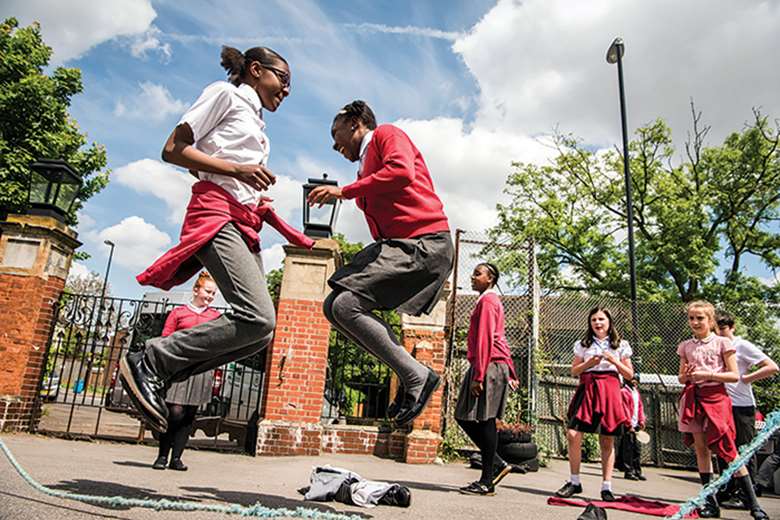The Play Return: A Review of the Wider Impact of Play Initiatives
Derren Hayes
Tuesday, May 30, 2017
The focus of this report is on children of school age, and on free play that takes place outdoors. It looks at quantitative evidence of the wider outcomes and impact of play.

- Author: Tim Gill, The Children's Play Policy Forum, (July 2014)
Interventions and initiatives
The report looks at four types of intervention that each involve setting aside time and space for children to play:
- Improving opportunities for free play in school break times
- Unstaffed public play facilities
- Supervised out-of-school play provision
- Street play initiatives.
It draws on a range of sources, including published reviews, material from academics and experts known to the author, and material identified as a result of a call for evidence via the membership of the Children's Play Policy Forum and the author's networks and website.
Benefits of play
Policy reviews and evaluation reports have concluded that playing leads to a wide range of interconnected beneficial outcomes for children, including cognitive development, physical health and development, mental health and emotional wellbeing, social development, and resilience.
Play in school
The study assessed the evidence on the impact of play initiatives and interventions in school during break times (also called playtime). It found that playground break time initiatives:
- Can involve higher levels of physical activity than organised sports
- Are linked with a range of improvements in academic skills, attitudes and behaviour
- Are linked with improved social skills, improved relations between different ethnic groups, and better adjustment to school life.
Unstaffed public play facilities
The impact of unstaffed play interventions in parks and public open spaces such as play areas and informal youth and sports facilities - was also analysed. These activities are harder to measure and there are more factors to gauge, including the characteristics of the neighbourhood, parental attitudes and fears, social and community factors (such as levels of trust) and various aspects of the provision of public spaces and the wider built environment.
As with play in schools, the bulk of studies have focused on physical activity, and include a number of systematic reviews. However, compared with play in schools, fewer studies have been carried out, and very few have used the most robust methodologies such as controlled trials. It found that public play facilities:
- Are linked to increases in children's physical activity, over and above the impact of the provision of public open space
- Are associated with family wellbeing by parents, and those who live near playgrounds and visit often report higher levels of family wellbeing
- Have led to reductions in levels of antisocial behaviour and vandalism.
Out-of-school provision
The settings covered in supervised out-of-school contexts include staffed adventure playgrounds, out-of-school clubs, and park-based and mobile play programmes. The research concluded evidence from academic studies is very limited. Consequently, the findings also take into account project and programme evaluations. It found that:
- Children are more physically active in free play sessions than in organised activities, and more active than they would be at home - and engagement with parents leads to increased physical activity at home
- Children's wellbeing is promoted through playing in a playwork setting with a strong focus on outdoor play in the natural environment
- Supervised play provision stimulates increased volunteering and social action.
Street play initiatives
The study also looked at interventions that increase children's play opportunities in residential streets, through regular, temporary road closures organised by local residents (typically for two to three hours once a week, fortnight or month). Due to the embryonic nature of street play schemes, studies are limited and the model has yet to be researched or evaluated extensively.
The findings draw on two evaluations, including one that used accelerometers to measure levels of physical activity. It found:
- Children are more physically active when taking part in street play sessions than at similar times of day when the streets are not closed
- Projects lead to increased interest in volunteering to support sessions.
Implications for practice
Drawing on the review of the empirical evidence, the report reaches the following conclusions about the wider impact of play initiatives:
- Play initiatives lead to improvements in children's physical and mental health and wellbeing, and are linked to a range of other cognitive and social developmental benefits. While evidence of beneficial outcomes is strongest for play in schools, Gill concludes it is reasonable to expect that they will also be seen in other contexts where children have comparable play experiences.
- Families and communities also benefit from play initiatives - and they generate high levels of volunteering and community action.
- Play initiatives are associated with inter-related benefits across a range of health and developmental areas. These should be taken as a whole.
- The improvement in opportunities for play is a valid outcome in its own right. Gill says there is sufficient empirical evidence for policymakers to be confident that initiatives that lead to improved play opportunities will also lead to wider benefits.
FURTHER READING
An Evaluation of Meriden Adventure Playground: Focus on Impact on Physical Activity and Healthy Eating, Nikita Price, Alison Trout, Journal of Playwork Practice, May 2017
Practice-based Research in Children's Play, edited by Wendy Russell, Stuart Lester, Hilary Smith, Policy Press, April 2017
Are Secondary School Environments Conducive for Active Play Opportunities? Brendon Hyndman, Barbara Chancellor, International Journal of Play, February 2017




